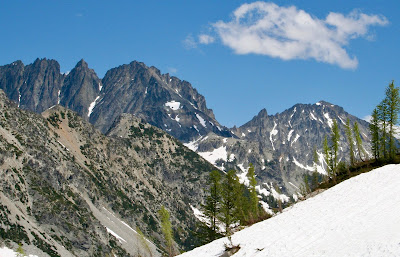About 45 years ago, I arrived at the Blue Mountain Work Center near Austin Junction, east of Prairie City, Oregon, from Eugene. A young college student at the University of Oregon School of Journalism in 1974, I was hired that summer as a wandering factotum -- sort of a jack-of-all-trades -- by the Malheur National Forest.
The year before, I worked as a tour guide at Crater Lake Lodge, Inc. This time around, it would be no glamour detail. I’d have to work, backpack and engage wilderness users throughout the entire forest. On the Malheur National Forest, I worked on all four ranger districts on the forest (Long Creek, Prairie City, Hines and Bear Valley).
I explored virtually the whole forest during my 6-month stint there. On Long Creek, I served as weekend sub on the Indian Rock Lookout (elevation 7,375), and Dixie Lookout (elevation 7,511). On the Prairie City District, I pulled sub duties on Antelope Lookout (elevation 6,456). Also marked timber and subbed on the helitack crew.
This wilderness is fairly small (68,700 square acres). By comparison, the Glacier Peak Wilderness, where I worked for nearly the next decade, is 566,057 square acres. We had no fewer than 15 wilderness rangers in Glacier Peak on six districts. I was one of that dedicated group of "wilderness strangers" for eight summers.
Yes, you’d be surprised how many obscure but tall peaks there are in the great divide between the Snake and Columbia Rivers near John Day. However, they are nothing a pissant couldn’t hop over compared to the North Cascades (below), where I would soon land, staying from 1975-82, and meet my lovely bride of 41 years.
As an aside, read “Astoria: Astor and Jefferson’s Lost Pacific Empire” by Peter Stark, where you’ll learn that John Day was a member of Astor’s overland party. He died nearby in a skirmish with the natives. No wonder Malheur is called “bad times” or “misfortune” by the French voyageurs who were part of the overland party.
After living at the Blue Mountain Work Center in Austin Junction, I moved the Forest Service housing in Prairie City (above), Yes, it’s the hub of cattle country (Oxbow was the big one), but timber production had gone downhill in the 70s, when the Hines mills shut down in John Day, Bates and other locations.
Prairie City is a one-horse town. John Day has slightly more to offer in terms of consumer goods. After all, it is the biggest town in Grant County. Still not much to look at, though. It’s a major intersection for two U.S. highways. I like Canyon City, in the shadow of Canyon Mountain two miles south of John Day. Much better pizza, too.
The Sumpter Valley Road (now Oregon Route 7) from Austin Junction to Baker City is very scenic and features many ghost towns (Austin, Whitney, Greenhorn and Granite, to name a few). I love ghost town lore, The Sumpter Valley Road to Baker City was paved a couple years after I left Austin Junction.
Much like other Eastern Oregon towns, they roll up the sidewalks about 9 p.m. Better be well stocked at home. As a college student from Eugene, I kept a pretty low profile among the NRA/bubba types in the John Day Valley. They would have executed me by firing squad if they could. It’s still Trump country, but imagine 1974.
In 1975, I was enticed to apply for a position on the Wenatchee National Forest by a girl I had met in Prairie City. Our romance didn’t work out, but I began a life-long love affair with the North Cascades, which are much more spectacular than anyplace in Eastern Oregon. Nonetheless, I very much enjoyed my stint on the Malheur.
On the Lake Wenatchee District alone, we had a dozen over 8,000- and 9.000-footers, including Clark Mountain (pictured) Mt. Maude, Seven-Fingered Jack, Buck Mountain, Copper Peak, Chiwawa Mountain, Fortress Mountain, Copper Mountain and others. And these peaks begin at 1,800 feet above sea level.
And did I even mention the glaciers? Glacier Peak has glaciers in its butt crack and creases. Washington has 90 percent of the glaciers in the Lower 48. Eastern Oregon might have one in the Eagle Cap Wilderness Area. I would know. Trails are steeper, and lusher with vegetation. And bugs.
Nonetheless, Oregon and Washington are both beautiful for many reasons. I’m grateful to have explored the wilderness in both states: Kalmiopsis Wilderness Area (Brookings), Crater Lake and environs, Three Sisters, Mt. Jefferson and especially Mt. Hood (below) and Mt. St. Helens, along with Glacier Peak and environs.
Wednesday, September 18, 2019
Subscribe to:
Post Comments (Atom)
















No comments:
Post a Comment